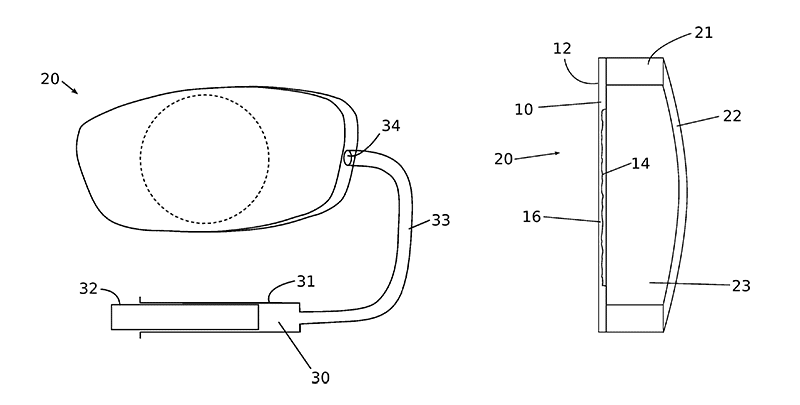Variable focus lenses for eyewear include a fluid-filled cavity that is bound in part by a deformable plastic membrane. Adjusting the volume of fluid within the cavity deforms the membrane, thereby changing the curvature of the lens.
It can be difficult to make rectangular, oval, or square shaped frames with fluid-filled lenses. Unlike in round lenses, a membrane attached to a non-round frame tends not to stretch uniformly when the volume of fluid within the cavity is adjusted.
In October 2020, The Centre for Vision in the Developing World C.I.C. was granted UK patent GB2539822B titled Variable focus lenses, which claims a variable focus lens and an associated manufacturing method.
In the illustrated example, the variable focus lens (20) comprises a fluid-filled cavity (23) and a fluid reservoir with variable volume (30) in fluid communication with the cavity. The volume of the cavity is controlled through adjustment of the reservoir volume. One of the walls of the cavity is a membrane (10), which includes a first surface (12) of optical quality – optionally, with a surface roughness (Ra) of less than two microns – and a second surface (14) with at least one area of non-optical quality and a surface roughness of greater than five micrometres.
The variable focus lens has a rigid support ring (21) with a rigid front plate (22). The reservoir, shown as a syringe body (31) with a plunger (32), is connected to the fluid-filled cavity via a flexible tube (33) through a bore (34) in the support ring. Optionally, adjustment of the reservoir volume may be controlled using dials, and a valve can be used to temporarily or permanently set the lens allowing the reservoir to be removed.
The membrane has a substantially circular or elliptical sub-region (16) of different thickness, and optionally, reduced thickness, as pictured. This may provide a spherical lens shape in a membrane that may otherwise be non-round. The refractive index of the fluid is matched to that of the membrane – this may ensure that no refraction occurs at the membrane/fluid boundary.
As light passing through the variable focus lens is not influenced by the shape of the membrane/fluid boundary in the sub-region, cost-effective manufacturing methods may be employed for producing membranes as compared with traditional plastic moulding methods.
The patent also discloses a method of making a variable focus lens which consists of forming a flexible membrane by shaping a side of it using a process with non-optical quality. This results in a surface roughness of greater than five micrometres. Examples of suitable methods described in the patent for producing the membrane include etching, 3D printing onto a preform, 3D printing the whole membrane and moulding the membrane.
This patented technology may greatly reduce the cost of eyeglasses with non-round, fluid-filled, variable power lenses, significantly improving access to corrective eyewear, particularly in the developing world.
Read the full patent here.
This article first appeared in the January 2021 issue of Materials World, the member magazine of the Institute of Materials, Minerals and Mining.
The Patent Eye blog offers a glimpse into the future by showcasing newly granted patents. Join us as we explore the latest innovations shaping our world.
The Patent Eye blog is made available by Alphabet Intellectual Property for informational purposes, in particular, sharing of newly patented technology from granted and published patents available in the public domain. It is not meant to convey legal position on behalf of any client, nor is it intended to convey specific legal advice.
Craving intellectual stimulus? Peer into the insights brought to you by The Patent Eye and explore our latest articles.


